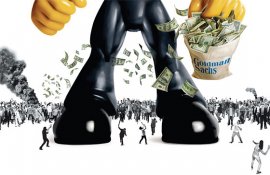
Tenacious G
 |
| Illustrations by Darrow (Goldman Sachs figure), Gluekit (small figures).
(Photo: Getty Images (crowd); Serge Attal/Time Life Pictures/Getty Images (crowd); Paula Bronstein/Getty Images (crowd); Harold Cunningham/Getty Images (smoke).) |
Thirty floors up in the black-tinted box that is Goldman Sachs headquarters on 85 Broad Street, there is a whiff of panic in the air. The Goldman of legendpillar of the free market, breeder of super-citizens, object of envy and awehas vanished. Ever since the bank crossed paths with U.S. taxpayers, getting saved with at least $10 billion in government aid last year and then parlaying that into $5.1 billion in profits in 2009 (so far), the firm has been seen as the ugly essence of capitalism at its most cynicalby Washington, by the public, by the financial press, even by some of its clients. Stalwart voices of Wall Street like the Financial Times and The Wall Street Journal have criticized the firm’s undue influence on government and its ruthless pursuit of risky profits. Venom is flowing from more unlikely quarters as well: A recent Rolling Stone article called Goldman a great vampire squid wrapped around the face of humanity and accused it of rigging every major market bubble since the Great Depression.
This is not the kind of attention Wall Street’s most vaunted financial institution is used to. Which is why I am now sitting in its wood-paneled and gold-trimmed executive suite: The famously press-averse firm has consented to a rare audience.
The man Goldman has selected to come to its defense is John Rogers, the firm’s chief of staff. Rogers is typical of the Goldman elitedoubling as a Washington power broker and confidant to James Baker, Jon Corzine, and Hank Paulson. The atmosphere is airless as Rogers sits down, his steady eyes barely blinking: a silver-haired sphinx in a sky-blue shirt. We don’t live in a vacuum, and we’re very aware of what the general public is thinking, says Rogers calmly. We work in a fiercely competitive global industry, but we can’t afford to be oblivious to public opinion.
Especially not as Goldman ramps up astronomical profits and prepares to pay its executives $11.4 billion and counting in this of all years. If the amount seems obscene to an outsider, it is justified on the inside by an article of faith: that Goldman employees are the absolute best of the breed, meant to wield the levers of powerand reap its rewards. As John Whitehead, the godfather of Goldman’s modern culture, wrote in a set of guidelines for executives: Important people like to deal with other important people. Are you one?
Of course, that’s not the message Goldman Sachs wants to send out at this particular moment. The goal here is to demystify the company, present it not as a nefarious organization set on world domination but as an American institution, a producer of public servants, its business synonymous with the capitalist system, its health reflective of the health of the economy as a whole.
I think this company is essential in terms of the American capital markets, says Rogers.
His tone is placid, soothinguntil, that is, the subject of American International Group comes up. At this, his eyes widen, his face grows angry, his hands gesture in the air.
If you didn’t like the policy, he says of the decision to bail out AIG and pay off its debts to Goldman, one avenue for pursuing your own interests was to attack Goldman Sachs.
It’s a sore spot for good reason. The AIG rescue is the incident from which all other Goldman conspiracy theories springthe original sin, in a sense, of Goldman’s current public tarring. It’s the act that first made the average man on the street sit up and say, Hey, wait a minute. The secretary of the Treasury, who used to be the Goldman CEO, just spent $85 billion to buy a failing insurance giant that happened to owe his former firm a lot of money. Does that smell right to you? It also seems to have the legs of a potential scandal, with Neil Barofsky, the inspector general overseeing the Troubled Asset Relief Program, conducting an audit of the buyout.


















